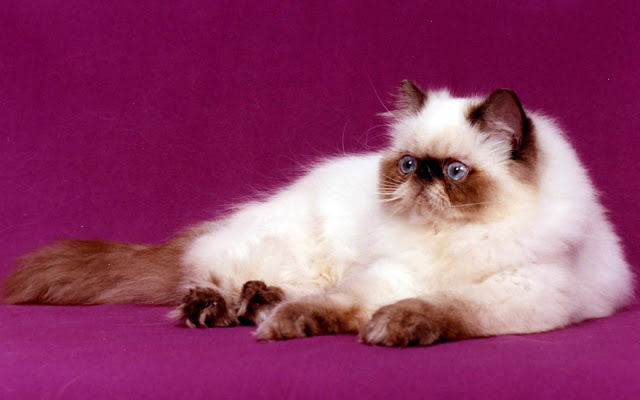Aside from the point shading and blue eyes, the Himalayan is very like the Persian. Truth be told, it is now and again alluded to as a "Colorpoint Persian." It gets its name from the Himalayan bunny, which has the equivalent colorpoint. The most conspicuous Himalayan, at any rate as of late, has been "Mr. Curse," the latrine flushing feline in the parody film Meet the Parents.
Actual Characteristics
This is a medium-to huge measured feline with hefty bones, a well-sew body, and a short tail. It has short legs and a long, thick, reflexive coat. The Himalayan's most striking highlights, nonetheless, are its expansive head and enormous, round, clear blue eyes.
There are two facial sorts for the Himalayan: outrageous and conventional. Albeit the current show pattern is toward a more extraordinary facial sort, felines of this kind are more inclined to medical issues. All things considered, the TCA (Traditional Cat Association) encourages pet proprietors to just gain conventional or "Doll-confronted" Himalayan felines.
Character and Temperament
The Himalayan is an ideal indoor partner; it talks more and is more dynamic than the Persian, yet is calmer than the Siamese. Despite the fact that delicate and harmony adoring, the Himalayan loves messing around, for example, get and getting into naughtiness, however it tends to be kept delighted by easiest toy or even a piece of paper. Moreover, a Himalayan can turn out to be very appended to its proprietor, requesting consistent consideration and spoiling.
History and Background
The birthplace of the Himalayan can be followed to the 1920s and '30s, when raisers in a few nations endeavored to deliver a feline with an ordinary Persian body, yet with Siamese markings. The main indications of achievement were found in the U.S. in 1924, when White Persians were crossed with Siamese, bringing about "Malayan Persians"; and in Sweden, when Dr. T. Tjebbes, a geneticist, created Persian/Siamese crosses.
In 1930, Dr. Clyde Keeler of Harvard University and Virginia Cobb likewise started a rearing project to determine how certain attributes could be acquired. The principal litter of dark, short-haired little cats was delivered by intersection a Siamese fem lager with a dark Persian male. A dark Persian female mated with a Siamese male delivered a comparable outcome. Empowered their trials, Dr. Keeler and Cobb. crossed a female of the second. litter with a male from the first. The finished result was "Debutante," the principal genuine Himalayan little cat (notwithstanding, it bore more similarity to the cutting edge Balinese feline than the Himalayan we see today).
After World War II, an American raiser by the name of Marguerita Goforth prevailing with regards to making the hotly anticipated Persian-like colorpoint. It was formally perceived as another variety by the Cat Fanciers' Association (CFA) and American Cat Fanciers' Association in 1957.
In 1984, in a move that amazed numerous reproducers, the CFA joined the Persian and Himalayan variety, guaranteeing they had comparative body types. Indeed, even today, some feline associations don't give this variety its own different name.
Notwithstanding, the variety presently has Championship status in all relationship (as the Himalayan or Persian) and was the most famous variety in 1996, as indicated by CFA measurements (which incorporate Persians).






Post a Comment